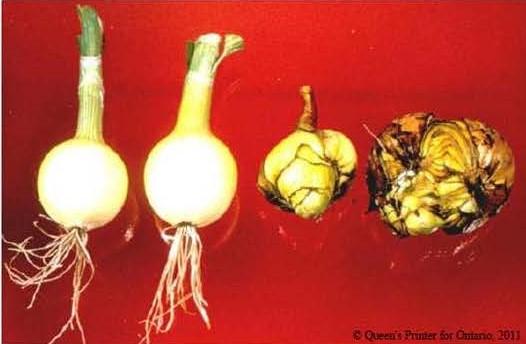Garlic Bloat Nematode Found in Several Garlic Samples
This must be a bad year for garlic because besides finding bulb mites we also have found garlic bloat nematode in several samples of damaged garlic. I wrote about this nematode last year and advised garlic growers to watch for it and to test any bad looking bulbs for it. This year growers are sending in their bad looking garlic bulbs and unfortunately many are infested with this nematode. The garlic bloat nematode Ditylenchus dipsaci can destroy a crop of garlic in one season. It probably came from Canada in garlic that was imported for food, but was planted as seed garlic. The problem then spread through distributors because there is no certification program for seed garlic and is it now widespread throughout New York. Symptoms of bloat nematode in garlic plants include: bloated, twisted, swollen leaves, distorted and cracked bulbs with dark rings (Fig. 1). Infested tissues become spongy, distorted and predisposes the plant to other problems like fusarium or white rot (Fig. 2) and bulb mites. These nematodes also can move to the inflorescence and remain in seeds for long periods of time in some plant species, i.e., beans, clover, and alfalfa where they are major sources of nematode dispersal. The nematodes can be spread around fields by equipment or on clothing and shoes. Garlic bloat nematodes can overwinter in soil or crop debris. If a grower has purchased or brought in new planting material over the last few years, especially if it came from Ontario or New York, you may have this pest. If you have not made any new introductions in a while you are probably safe. If you have garlic bulbs that look something like they do in figure 1 or 2 you should send a sample to a nematode laboratory for testing.

